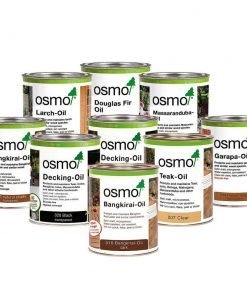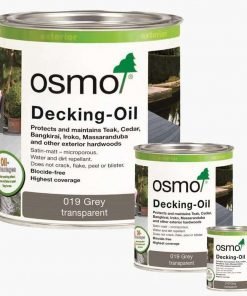28,33 £ – 82,50 £
Natural decking oil based protective finish for exterior wood that does not peel, crack, flake or blister. Microporous, breathable finish allowing the wood to breath and reduces the risk of swelling and shrinkage. Water-repellent, extremely weather and UV resistant. Easy to apply as well as renew, no sanding or primer necessary. When dry, the finish is safe for humans, animals and plants and is suitable for children’s toys as per EN 71.3 (European norm).
Osmo Natural Decking Oil 0.75/2.50 L
The decking wood covered with Osmo oil with wax looks very solid, the pigments in it highlight the wood pattern and the wax gives the surface a smooth finish. Also, the wax in the oil fills micropores in the wood and prevents the ingress of water and dirt. However, the micropores in the wood are not clogged and do not form a watertight film, so the wood can absorb and release water without any harm. Micro-porous wood can breathe, provide better air quality and is anti-static (less dust absorbent) – a great solution for people with allergies.
Decking Oil – Advantages
✓ Effectively colors pressure treated and untreated woods
✓ Natural wood character and grain remains visible
✓ UV-Resistant (except Teak)
✓ Microporous finish that will not crack, peel or flake
✓ Safe for animals and plants once dry – naturally!
✓ Very water and dirt resistant – water beads on surface
✓ Reduces wood swelling and shrinkage
✓ No sanding necessary for future applications
✓ German quality = Easy application with professional excellent results
Decking Oil – Preparation
- Decking boards must be clean, dry and frost-free prior to applying Osmo Decking Oil.
- Old paints, varnishes and other coatings must be removed by sanding or stripping back to clean, bare wood.
- Old applications of oil based treatments or stains need to be cleaned or lightly sanded.
- If sanding, use a 80 to 100 grit sandpaper and remove all traces of sanding dust before oiling.
- Hardwoods with an especially high content of oil, leave to weather for about 2 to 3 months (in winter up to 5 months) or using Osmo Decking Cleaner to decrease the surface.
- Hard wood with a high content of natural wood extractives needs to weather off (for at least 4 weeks) before the initial treatment or to be cleaned with Osmo Decking Cleaner.
- Resinous wood e.g. Larch or Douglas Fir needs to weather off for at least 6 weeks.
- Pressure impregnated wood, Massaranduba, Bangkirai or Garapa need to weather off for at least 3 months.
- Use Osmo Wood Reviver Gel to clean the wood surface and remove greying before applying a decking oil
Decking Oil – Application
Always do a test area before starting any project to check suitability and compatibility. Follow the manufacturer’s instructions on the tin at all times. The type and age of timber can have a dramatic impact on how much Decking-Oil you need. As an example, softwood decking that is old will likely require more oil than a relatively new hardwood decking that still retains a fair amount of natural oil.
To test how much oil your decking needs, apply one thin coat, allow to dry, then apply a droplet of oil in a corner. If the droplet of oil soaks into the wood then a further coat can be applied. Repeat this process until the droplet of oil sits as a bead on the surface of the wood and no longer soaks in to the timber. This is an indication that the timber has absorbed as much oil as possible and doesn’t require any more.
Stir the contents of the tin thoroughly before and periodically during use.
- Use an application brush or decking applicator to apply the decking oil thinly and evenly, along the wood grain.
- For a quick and easy application, we recommend using the Osmo Floor Brush which is perfect for decking and allows for the decking oil to be applied from a standing position when used with the Osmo Telescopic Handle.
- When applying decking oil, If possible apply the first coat on all sides of the decking boards before installation.
- Wipe off any excess decking oil and allow 10 to 12 hours drying time, with good ventilation, then apply the 2nd coat – also thinly
Available oil colors: Douglas fir – 004; Bangkirai – 006 (light); Teak – 007 (clear); Larch – 009; Thermowood – 010; Garapa – 013; Massaranduba – 014; Bangkirai – 016 (dark); Grey – 019; Bog oak – 021;
Caution: The appearance of the product or the packaging (container) on the picture may not correspond to the actual appearance of the product or the size of the packaging.
| Weight | 1,1 kg |
|---|---|
| Dimensions | 12 × 12 × 12 cm |
| Type of wood | Thermo wood, Coniferous wood, Hardwood wood, Exotic wood, Other species … |
| Product packaging | |
| Unit of measurement | |
| Country of origin | |
| Delivery term |
DECK AND FACADE COATINGS
Does not crack or peel
Renovation without sanding is possible
Provides a permanent "moisture" effect
Forms a protective microporous surface
High water resistance and easy maintenance
Penetrates into the wood and protects the surface
Protects wood from inside and does not form a film
FIRST COAT
Apply the first coat of oil on untreated and outside used / stored wood at about 35 ml / m².
POSSIBLE CORRECTIONS
Excess oil and wet layer defects can be corrected within 30 minutes of the first application.
DRYING TIME
Drying time about 12 hours, low temperature and high humidity prolong the drying time.
SECOND COAT
Apply a second coat of oil about 35 ml / m² (If you are renovating wood, apply on a clean and dry surface).
COVERAGE WITH ONE COAT
Oil consumption: 1 liter - about 24 - 26 m² in one coat (tools used for work: brush, roller, sponge, trowel, etc.).
COVERAGE WITH TWO COATS
Oil consumption: 1 liter - about 12 - 13 m² in two coats (working tools: brush, roller, sponge, brush, etc.).























